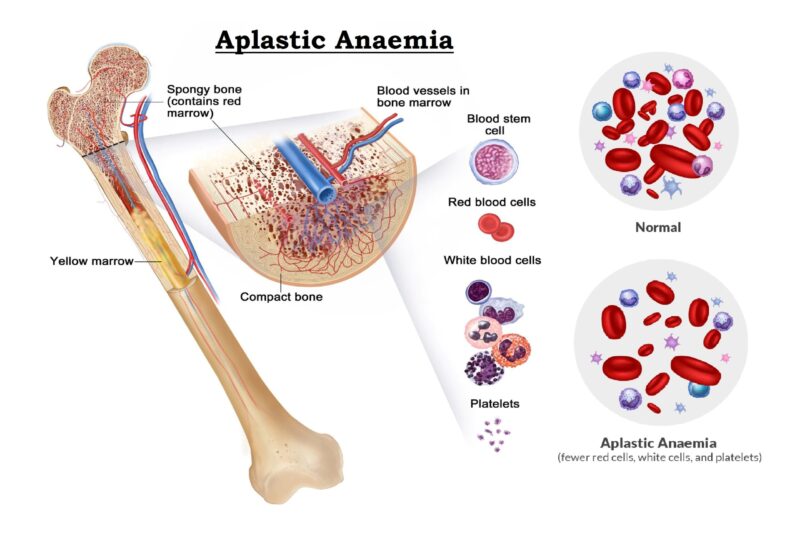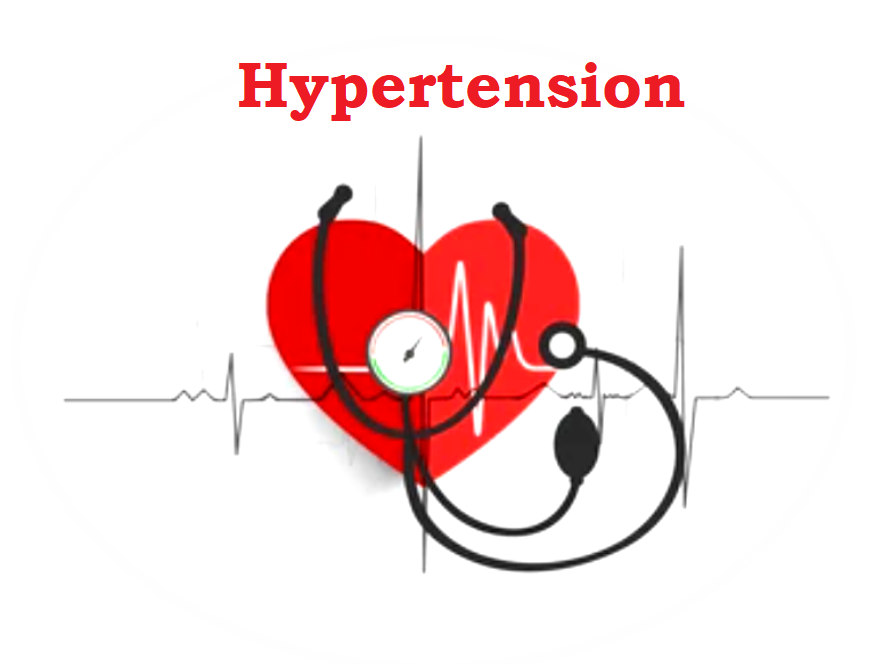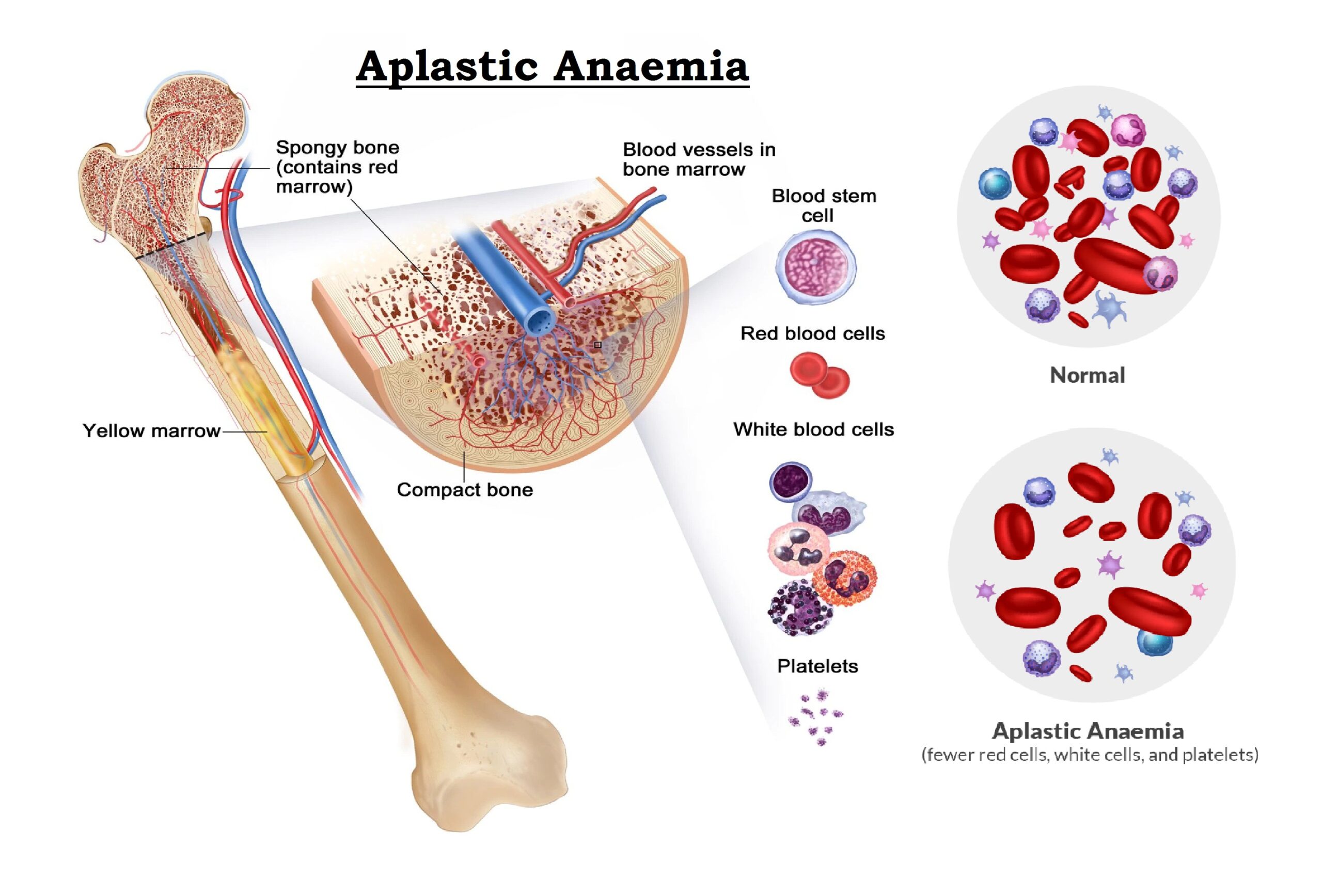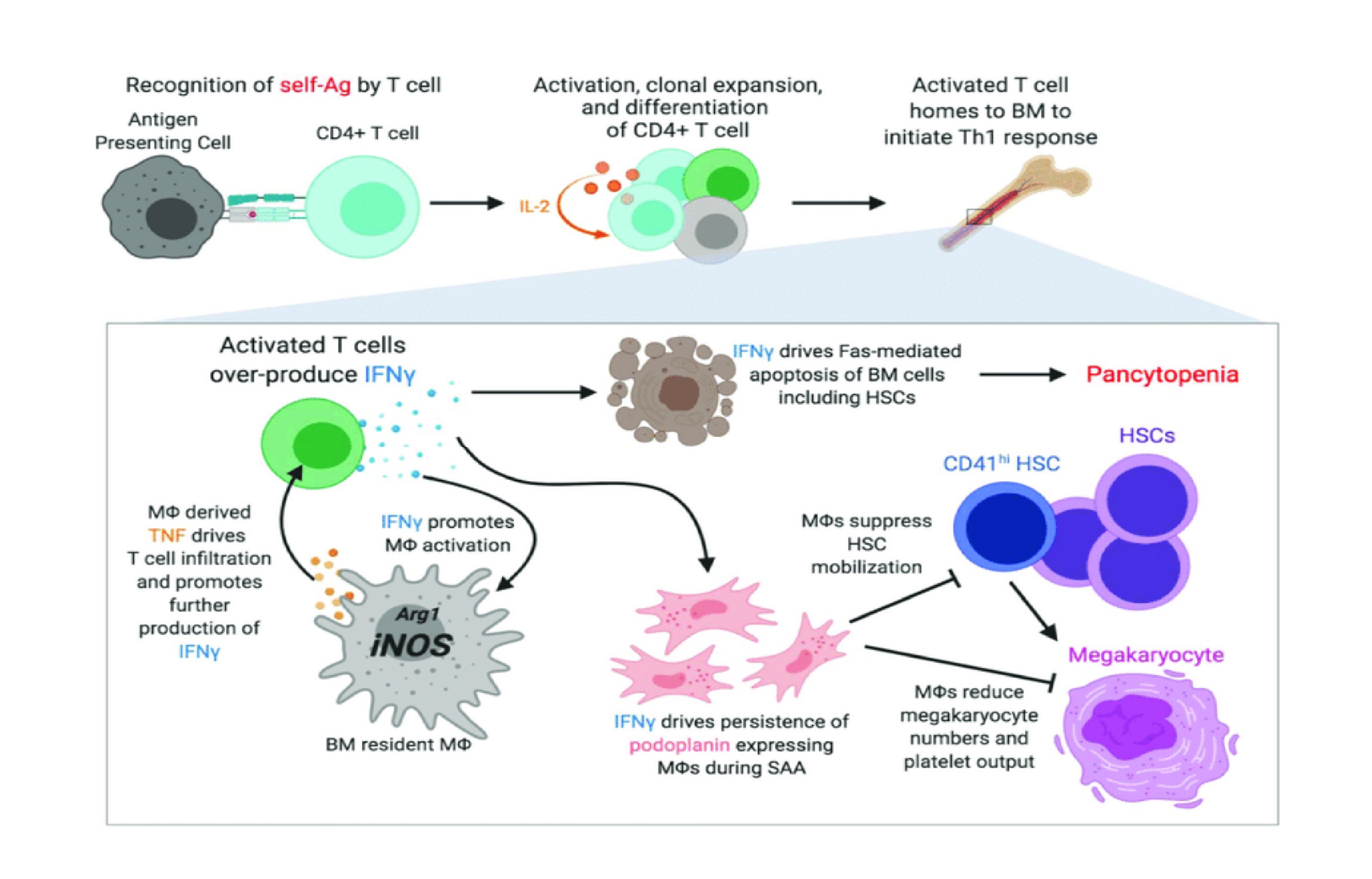Aplastic Anaemia: Sign and Symptoms, Causes, Risk factors, Diagnosis, Complications, Treatment and Prevention
Aplastic anemia is a syndrome of bone marrow failure characterized by peripheral pancytopenia (deficiency of all three cellular components of the blood - red cells, white cells and platelets) and bone marrow hypoplasia (stem cell present in the bone marrow fails to produce sufficient numbers of blood cells in the body). Aplastic anemia is a rare but serious noncancerous disorder in which the bone marrow is unable to produce adequate quantity blood cells required for survival. It is estimated that the incidence of aplastic anemia is 0.7–4.1 cases per million people worldwide, with the prevalence between men and women being approximately equal. The incidence rate of aplastic anemia in Asia is 2–3 times higher than it is in the West; the incidence in the United States is 300–900 cases per year. It occurs most frequently in people in their teens and twenties but is also common among the elderly.
Actually, there are two different types of aplastic anaemia - Inherited aplastic anemia and Acquired aplastic anemia. However, in many instances about 75% the underlying cause for the disease is unknown (idiopathic aplastic anemia). Inherited aplastic anemia is caused by gene defects, and is most common in children and young adults. If anyone has this type of anaemia, there is a higher chance of developing leukemia and other cancers. So, at early stage of the disease proper medication is mandatory regularly under the supervision of specialist physician. Acquired aplastic anemia is more common in adults. Researchers believe something triggers problems in the immune system, most cases of severe aplastic anemia happen when the body’s immune system attacks its own tissues and organs. The possibilities include Viruses like HIV, Hepatitis, Cytomegalovirus, or Epstein-Barr, certain medications, or exposure to toxic chemicals, radiation or chemotherapy treatment for cancer. Although aplastic anemia is not a cancer, its treatment can be similar to therapies used to treat leukemias and lymphomas.
Sign and Symptoms of Aplastic anaemia:
The signs and symptoms of aplastic anaemia vary from person to person and on the severity of the cell count deficiency. Problems tend to develop slowly, often over a number of years. Because of acquired aplastic anaemia develops slowly, person may not notice symptoms of the disease for months or even years and many of these symptoms, especially fatigue, Weakness, Headaches and Dizziness, are common and do not necessarily mean person have a bone marrow problem. Aplastic anaemia may not cause noticeable symptoms in the early stages if it not treat properly in early stage than it can cause a number of health problems, such as Tiredness, Shortness of breath, Dizziness, Pale skin, Chest pain, Irregular heartbeat, Heart failure, Chronic infection, Easy bruising and bleeding, Nosebleeds etc. Some common signs and symptoms of aplastic anaemia may include:
- Low red blood cell count:
-
- Tiredness.
- Fatigue.
- Dyspnea (Shortness of breath).
- Dizziness.
- Pale skin.
- Headaches.
- Chest pain.
- Irregular heartbeat, an enlarged heart, or heart failure.
-
- Frequent Infections.
- Fever.
- Low platelet count:
-
- Easy bruising and bleeding.
- Nosebleeds.
- Bleeding/bruising easily.
- Heavy menstrual bleeding.
Aplastic anemia symptoms can affect people differently. They may come on slowly or suddenly. Some people may have manageable, mild symptoms. Others may have symptoms that indicate severe aplastic anemia. Severe aplastic anemia requires urgent medical treatment.
Causes and Risk factors of Aplastic anaemia:
Aplastic anemia is a rare but serious noncancerous disorder in which the bone marrow is unable to produce adequate quantity blood cells required for survival. Because of acquired aplastic anaemia develops slowly, person may not notice symptoms of the disease for months or even years.
Often, Healthcare providers cannot identify exact causes of aplastic anemia. Some of the common causes of aplastic anaemia include.
- Autoimmune disorders, which are the most common cause of aplastic anaemia. Acquired aplastic anemia is a T-cell mediated autoimmune disease.
- Exposure to toxic chemicals such as pesticides, arsenic, and benzeneor with the use of certain drugs, including chloramphenicol, carbamazepine, felbamate, phenytoin, quinine, and phenylbutazone. However, the probability that these drugs will lead to aplastic anemia in a given patient is very low.
- Radiation therapyand chemotherapy for cancer; Exposure to ionizing radiation from radioactive materials or radiation-producing devices.
- Viral infections such as HIV, Hepatitis, Cytomegalovirus, or Epstein-Barr virus and Parvovirus B19.
- Pregnancy; immune system of pregnant mother might attack bone marrow during pregnancy.
However, in many instances about 75% the underlying cause for the disease is unknown called idiopathic aplastic anemia.
Diagnosis of Aplastic anaemia:
In the early stage of diagnosis, it’s complicated to differentiated Aplastic anemia and pure Red cell aplasia. In aplastic anemia, the patient has pancytopenia (i.e., also leukopenia and thrombocytopenia) resulting in a decrease of all formed elements. In contrast, pure red cell aplasia is characterized by a reduction in red cells only. The diagnosis can only be confirmed with a bone marrow examination. Before Bone marrow examination, a patient will generally have had other blood tests to find diagnostic clues, including a complete blood count, renal function test and serum electrolytes analysis, liver function test specially enzymes, thyroid function tests, vitamin-B12 and folic acid levels. Tests that may aid in determining an etiology for aplastic anemia include:
- History of iatrogenic exposure to cytotoxic chemotherapy: transient bone marrow depression.
- Vitamin B12and folic acid levels: vitamin deficiency.
- Liver function test: liver diseases (cirrhosis of liver etc.).
- Viral studies: Viral infections such as HIV, Hepatitis, Cytomegalovirus, or Epstein-Barr virus and Parvovirus B19.
- Chest X-ray: Frequent Respiratory Tract infections.
- X-rays, Computed Tomography (CT) scans, or Ultrasound imaging tests: enlarged lymph nodes (sign of lymphoma), kidneys, and bones in arms and hands (abnormal in Fanconi anemia)
- Antibody test: immune competency
- Blood tests for paroxysmal nocturnal hemoglobinuria.
- Bone marrow aspirate and biopsy: To rule out other causes of pancytopenia (i.e., neoplastic infiltration or significant myelofibrosis).
Treatment of Aplastic anaemia:
Treatments for aplastic anemia, which will depend on the severity of condition and age of the patient, might include observation, blood transfusions, medications, or bone marrow transplantation. Most people with aplastic anemia will need a blood transfusion at some point. If blood cell count is very low, doctor may suggest a bone marrow or stem cell transplant to boost body’s ability to make blood cells. The treatment will be based on how severe the anemia is and what is causing it. Treatments can include:
- Bone marrow Transplantation/ Stem Cell Transplant: Aplastic anemia was one of the first diseases for which bone marrow transplantation was found to be effective. In this therapy, the patient's non-functioning bone marrow is destroyed with drugs and/or radiation and replaced with donor bone marrow with stem cells from a compatible donor, usually a sibling or other family member. Bone marrow transplants from unrelated donors or donors that do not match a patient’s bone marrow characteristics are usually saved for severe aplastic anemia or very severe aplastic anemia patients who have not responded to drug therapy first.
The procedure requires a lengthy hospital stay. After the transplant, patient will receive drugs to help prevent rejection of the donated stem cells. A stem cell transplant carries risks. Patient body may reject the transplant, leading to life-threatening complications. Patients under age 40 are the best candidates. Cure rates decline significantly in those over 40.
- Blood Transfusion: Although, blood transfusions are not a cure for aplastic anaemia, it can relieve the symptoms by supplementing the body with blood cells that the bone marrow cannot produce. Transfusions can quickly stabilize aplastic anemia patients with severe blood cell deficiencies, but it is very rare for a patient to achieve long-term recovery using this form of treatment alone. A blood transfusion may involve the administration of red blood cells or platelets.
- Red blood cells: This will improve the red cell counts and relieve the symptoms of anaemia including pale skin and fatigue.
- Platelets: This will help to prevent excessive bleeding and bruising.
Although there is no limit to the number of blood transfusions a person can undergo, repeated transfusions might lead to complications such as:
-
- Iron Overload:The excess iron from the blood transfusions may accumulate in the body and cause damage to vital organs if left untreated. If required, medications to help remove the excess iron from the body can be given.
- Development of antibodies against transfused blood products: After repeated transfusions, the body’s immune system may develop antibodies against the transfused blood products making them less effective. An immunosuppressant medication may be recommended to reduce the risk of this happening.
- Medicinal Therapy : In some patients, bone marrow transplants may not be an option; Doctor may prescribe medication to try to stop body from attacking bone marrow. While drug therapy is not a cure for aplastic anemia, it may partially restore blood cell production. However, up to 50% of patients relapse or develop other blood-forming malignancies or disorders.
- Immunosuppressant drug therapy : For people who can't undergo a bone marrow transplant or for those whose aplastic anemia is due to an autoimmune disorder, treatment can involve drugs that alter or suppress the immune system (immunosuppressants). Drugs such as cyclosporine (Gengraf, Neoral, Sandimmune) and anti-thymocyte globulin suppress the activity of immune cells that are damaging bone marrow. This helps bone marrow recover and generate new blood cells. Cyclosporine and anti-thymocyte globulin are often used together. Corticosteroids, such as methylprednisolone (Medrol, Solu-Medrol), are often used with these drugs.
- Bone marrow stimulants therapy : Certain drugs — including colony stimulating factors, such as sargramostim (Leukine), filgrastim (Neupogen) and pegfilgrastim (Neulasta), epoetin alfa (Epogen/Procrit), and eltrombopag (Promacta) — help stimulate the bone marrow to produce new blood cells. Growth factors are often used with immune-suppressing drugs.
- Antibiotics and Antifungal therapy : Having aplastic anemia weakens body’s immune system, which leaves more prone to infections. If patient have aplastic anemia; don't want the infection to get worse, because it could prove life-threatening. If person have severe aplastic anemia, doctor might prescribe antibiotics or antiviral medications to help prevent infections.
- Other Treatment : Aplastic anemia caused by radiation and chemotherapy treatments for cancer usually improves after those treatments stop. The same is true for most other drugs that induce aplastic anemia. Pregnant women with aplastic anemia are treated with blood transfusions. For many women, pregnancy-related aplastic anemia improves once the pregnancy ends. If that doesn't happen, treatment is still necessary.
- Supportive Care : A central venous catheter – a tube that carries medicines to a vein in the chest – may be helpful for aplastic anemia patients who require frequent transfusions or infused medications. Patients with deficiencies in certain blood elements may need infused blood products, such as packed red blood cells to correct or avoid heart and lung complications. Platelet infusions may be needed to prevent spontaneous bleeding. Because fungal and bacterial infections are a major cause of death in patients with severe aplastic anemia, patients may require therapy with antibiotics, or with antiviral or anti-fungal drugs.
There's no prevention for most cases of aplastic anemia. Avoiding exposure to radiation, insecticides, herbicides, organic solvents, paint removers and other toxic chemicals might lower risk of the disease.






